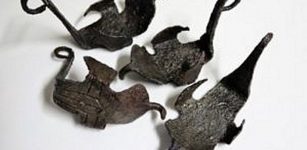Scribes: One Of The Noblest And Highly Recommended Professions In Ancient Egypt
A. Sutherland - AncientPages.com - Ancient Egypt did not have a public school system, so the average Egyptian could neither read nor write. It is estimated that less than one percent of Egyptians—at least during the Old Kingdom—were literate.
This early New Kingdom statue commemorates the scribe Minnakht ("Strength of Min") and demonstrates how ancient scribes read papyri – in a seated position on the floor with the text on their lap. Image credit: Walters Art Museum - Public Domain
Therefore, scribes were widely needed in the country. They represented the largest group of workers (after farmers), including thousands of officials, individuals hired to handle various accounts, official correspondence for large estates, and many freelancers.
Successful scribes never had to do manual labor as others, and society respected them widely.
Sources about ancient Egyptian scribes are known not only from tombs and depictions but also papyri, various seals, and graffiti.
The ancient site in Gebelein, known for its cemetery, has archeological finds stretching from the Predynastic Period to the Middle Kingdom, including a beautiful example of a scribe's wooden box containing lumps of black and red ink, papyri, reeds, and a mortar (dated to the fourth dynasty).
Much of what we know today about ancient Egypt comes from the country's scribes, some of the most valuable professionals who were educated in writing. This writing included hieroglyphics, hieratic scripts, and the demotic script (the first millennium BC), mainly used as shorthand for commerce and arithmetic.
Thoth was the god credited with the invention of writing by the ancient Egyptians. He was the scribe of the gods who kept knowledge of scientific and moral laws. Ancient Egyptian scribes and officials left for us, ordinary people, excellent knowledge about the country's political, administrative, and economic activities due to the records, books, and inscriptions.
Thanks to the scribes, various documents mentioned all of Egypt's social classes and representatives of other nationalities.
Not Everyone Could Become A Scribe
A particular school was needed for scribes to become scribes. You would learn how to read and write hieroglyphics and hieratic scripts at this school. Usually, according to family tradition, the children of scribes became scribes. They were brought up in the same scribal tradition, sent to school, and inherited their fathers' positions after entering the civil service.
Statue of a scribe of the 5th dynasty, Museum at the necropolis of Saqqara; Catalogue Generale no. 63; statue belonged to a person called Ptahshepses and was found in Saqqara mastaba C10; numbering according to Maspero. Image credit: Harald Gaertner - CC BY-SA 3.0
Also, the sons of higher officials, sometimes even farmers' children, and the sons of artisans could attend local temples for instructions in letters.
Long Hard Work And Much Studies To Become A Scribe
It was hard work that usually took four to five years to go through scribe school, where all scholars were male. The scribe needed writing reed brushes dipped in red and black ink for daily work.
Most often, a professional scribe wrote on papyrus. However, the scribes could not do papyrus exercises during the studies because they were costly materials.
Early in the morning, each scribe came to his work with a small basket containing some bread and beer and returned home late afternoon. The students had to confront and learn many complicated scripts, including various signs. At first, they spent plenty of time acquainting themselves with hieroglyphic symbols by repeatedly copying them onto old pottery fragments, limestone flakes, or wood boards with replaceable surfaces until they remembered them perfectly.
Black ink was used for the body of a text, and red to mark chapter headings or significant phrases.
Later, after learning all the necessary basics, the student could begin copying onto papyrus, and yet, the scribe's other skills were needed though they were not easily mastered.
In the "Daily Life of the Ancient Egyptians" by Bob Brier and A. Hoyt Hobbs, we read:
"In addition to hieroglyphs - the picture symbols we most often associate with Egyptian writing - a more cursive form called hieratic was employed for handwriting, and a more abbreviated version called demotic was used for quick notes. When all three symbol systems had been committed to memory, a pupil who showed aptitude could move to advanced courses in mathematics and basic building practices, both of which were taught through practical examples rather than abstraction rules..."
Once again, it is important to stress that these studies were complex and, first of all, very boring for many children.
Scribes Had Many Privileges
Despite difficulties in their studies, however, many students successfully graduated and could become professional scribes with many privileges. As a scribe, a young man could enjoy opportunities for advancement. Specific orders of Egyptian priests required scribal skills, as did the quartermaster corps of the army and many government jobs.
Scribes were considered part of the royal court, were not enrolled for compulsory military service, and did not pay taxes. They were also free from the heavy manual labor and worked with painters and artisans who decorated reliefs and other building works with scenes, prominent figures, or hieroglyphic text.
Egyptian scribes were also extremely busy copying books of the dead for thousands of customers interested in immortality. Such copies did not always represent good quality; many scrolls (incredibly different spells) were beautifully decorated with colored paintings. Others were brief with no illustrations, but people paid for them, and generally, all the scribes' customers were satisfied.
Written by – A. Sutherland - AncientPages.com Senior Staff Writer
Updated on June 27, 2024
Copyright © AncientPages.com All rights reserved. This material may not be published, broadcast, rewritten or redistributed in whole or part without the express written permission of AncientPages.com
Expand for referencesReferences:
Rawlinson G. "Ancient Egypt"
Williams, R. J. Scribal Training in Ancient Egypt
More From Ancient Pages
-
 Remarkable ‘Hipposandals’ Found At Vindolanda
Archaeology | Aug 18, 2018
Remarkable ‘Hipposandals’ Found At Vindolanda
Archaeology | Aug 18, 2018 -
 Airmid: Irish Goddess Of Healing And Herbs And One Of The Tuatha Dé Danann
Celtic Mythology | Feb 2, 2018
Airmid: Irish Goddess Of Healing And Herbs And One Of The Tuatha Dé Danann
Celtic Mythology | Feb 2, 2018 -
 The Americas Were Not Populated Via The Ice-Free Corridor More Than 15,600 Years Ago – New Study Of Boulders Reveals
Archaeology | Mar 23, 2022
The Americas Were Not Populated Via The Ice-Free Corridor More Than 15,600 Years Ago – New Study Of Boulders Reveals
Archaeology | Mar 23, 2022 -
 Huge Unknown 7,000-Year-Old Vinca Settlement Found In Serbia?
Archaeology | Apr 30, 2024
Huge Unknown 7,000-Year-Old Vinca Settlement Found In Serbia?
Archaeology | Apr 30, 2024 -
 Legend Of Bochica And Mysterious Ancient Stone Structures In Colombia
Featured Stories | Jun 5, 2016
Legend Of Bochica And Mysterious Ancient Stone Structures In Colombia
Featured Stories | Jun 5, 2016 -
 Medicine in Antiquity: From Ancient Temples To Roman Logistics
Archaeology | Apr 13, 2018
Medicine in Antiquity: From Ancient Temples To Roman Logistics
Archaeology | Apr 13, 2018 -
 Unexplained Lights Over English City Reported By Police May Have A Deeper Meaning
Featured Stories | Dec 11, 2019
Unexplained Lights Over English City Reported By Police May Have A Deeper Meaning
Featured Stories | Dec 11, 2019 -
 Viklaumadonna Hides A Thousands-Year-Old Secret
Artifacts | Jan 5, 2020
Viklaumadonna Hides A Thousands-Year-Old Secret
Artifacts | Jan 5, 2020 -
 Did Our Ancestors Know About Artificial Intelligence?
Ancient Technology | Sep 2, 2015
Did Our Ancestors Know About Artificial Intelligence?
Ancient Technology | Sep 2, 2015 -
 On This Day In History: Bishop of Gloucester John Hooper is Burned At The Stake For Heresy- On Feb 9, 1555
News | Feb 9, 2017
On This Day In History: Bishop of Gloucester John Hooper is Burned At The Stake For Heresy- On Feb 9, 1555
News | Feb 9, 2017 -
 Central European Early Iron Age ‘Hascherkeller’ Reveals Its Secrets
Archaeology | Jul 20, 2022
Central European Early Iron Age ‘Hascherkeller’ Reveals Its Secrets
Archaeology | Jul 20, 2022 -
 New Models Shed Light On Life’s Origin
DNA | Feb 13, 2023
New Models Shed Light On Life’s Origin
DNA | Feb 13, 2023 -
 Something Never-Before-Seen Is Hidden Beneath 15 Giant Viking Burial Mounds Spotted By Radar In Norway
Archaeology | Jan 19, 2021
Something Never-Before-Seen Is Hidden Beneath 15 Giant Viking Burial Mounds Spotted By Radar In Norway
Archaeology | Jan 19, 2021 -
 Rainbow Was A Powerful Symbol In People’s Ancient Beliefs
Ancient Symbols | Jul 26, 2018
Rainbow Was A Powerful Symbol In People’s Ancient Beliefs
Ancient Symbols | Jul 26, 2018 -
 Pergamon – One Of ‘Seven Churches Of Asia’ With Great Library And Sophisticated Water Supply System
Civilizations | Jul 25, 2018
Pergamon – One Of ‘Seven Churches Of Asia’ With Great Library And Sophisticated Water Supply System
Civilizations | Jul 25, 2018 -
 King Tut’s Face Reconstructed By Bioarchaeologist
Archaeology | Nov 26, 2022
King Tut’s Face Reconstructed By Bioarchaeologist
Archaeology | Nov 26, 2022 -
 Origins Of Maya Civilization More Complex Than Thought
Civilizations | Apr 26, 2013
Origins Of Maya Civilization More Complex Than Thought
Civilizations | Apr 26, 2013 -
 8,000-Year-Old Yarmukian ‘Mother Goddess’ Figurine Discovered In Israel
Archaeology | Jul 18, 2022
8,000-Year-Old Yarmukian ‘Mother Goddess’ Figurine Discovered In Israel
Archaeology | Jul 18, 2022 -
 Summer Solstice Festivals Around The World – Midsummer Celebration Is An Ancient Tradition Still Alive
Ancient Traditions And Customs | Jun 21, 2024
Summer Solstice Festivals Around The World – Midsummer Celebration Is An Ancient Tradition Still Alive
Ancient Traditions And Customs | Jun 21, 2024 -
 Extremely Rare Ancient Coin Of Short-Lived Roman Ruler Laelianus Discovered
Archaeology | Jun 25, 2019
Extremely Rare Ancient Coin Of Short-Lived Roman Ruler Laelianus Discovered
Archaeology | Jun 25, 2019


